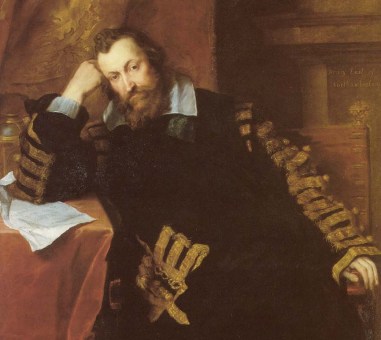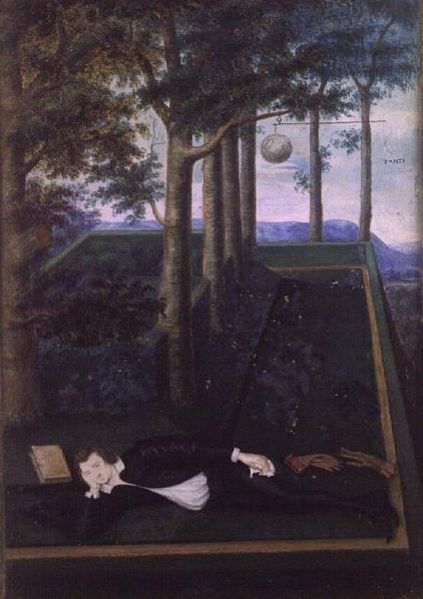<Back to Index>
- 9th Earl of Northumberland Henry Percy, 1564
PAGE SPONSOR


Henry Percy, 9th Earl of Northumberland (27 April 1564 – 5 November 1632) was an English aristocrat. He was a grandee and one of the wealthiest peers of the court of Elizabeth I. Under James I, Henry was a long term prisoner in the Tower of London. He is known for the circles he moved in as well as for his own achievements. He acquired the sobriquet The Wizard Earl (also given to Gerald FitzGerald, 11th Earl of Kildare), from his scientific and alchemical experiments, his passion for cartography, and his large library. His mild deafness and slight speech impediment did not prevent him from becoming an important intellectual and cultural figure of his generation.
He was born at Tynemouth Castle in Northumberland, England, the son of Henry Percy, 8th Earl of Northumberland, whom he succeeded in 1585. He was brought up a Protestant, as his father had been, taking instruction from the vicar of Egremont. This did not prevent suspicions in later life, particularly when he associated with Charles Paget, that he was a crypto - Catholic. Around 1586, he first employed the artist Nicolas Hilliard paying 60 shillings for his portrait.
Although his title was from the north of England, Percy also had estates in the south at Petworth House, and also at Syon House, a few miles north of Richmond - upon - Thames, acquired by his marriage to Dorothy Devereux (sister of Robert Devereux, 2nd Earl of Essex) in 1594.
They had four children:
Dorothy (c.1598 - 20 August 1659), married Robert Sidney, 2nd Earl of Leicester, by whom she had six children.
Lucy (1599/1600 - 5 November 1660), married as his second wife James Hay, 1st Earl of Carlisle.
Algernon (29 September 1602 - 13 October 1668), married firstly, Anne Cecil, by whom he had five daughters, including Lady Elizabeth Percy, Countess of Essex; he married secondly, Lady Elizabeth Howard, by whom he had his heir, Joceline Percy, 11th Earl of Northumberland.
Henry (1604 - April 1659), died unmarried.
Through her eldest daughter Dorothy, Countess of Leicester, she was an ancestress of Diana, Princess of Wales. Though it did produce a male heir, Algernon, the marriage was not successful, and the couple separated after a time.
The Percy family was still largely Catholic, while Henry was at least nominally Protestant. When it became clear that the Protestant James VI of Scotland was likely to succeed Elizabeth, Henry sent Thomas Percy, a recent Catholic convert, on a secret mission to James's court three times in 1602. He said that English Catholics would accept James as king if he reduced the persecution of Catholics. Henry employed Thomas Percy as a rent collector at Syon House. Thomas was the great - grandson of the 4th Earl of Northumberland, but was unscrupulous, with 34 charges of dishonesty brought against him. Henry wrote to James "It were a pity to lose a good Kingdom for not tolerating a mass in a corner". Through Thomas Percy, Henry received loosely worded assurances of religious tolerance from James.
Shortly before James's accession to the English throne in 1603, Robert Cecil, 1st Earl of Salisbury, through Lord Henry Howard particularly warned the king against Henry Brooke, 11th Baron Cobham, Sir Walter Raleigh, and Percy. This theory of the "diabolical triplicity" rested on innuendo, about the occult interests supposedly cultivated by the intellectual circles led by Percy and Raleigh, and possibly on the traitorous intent suggested only by rumors from the 1580s that Percy would marry Arbella Stuart. Brooke led the Main Plot against James, and Raleigh soon lost his freedom. Percy, on the other hand, was appointed to the Privy Council.
Thomas Percy went on to become one of the five conspirators in the Gunpowder Plot of
1605. When the plot was discovered Thomas fled and was besieged at
Holbeache House in Warwickshire. On 8 November 1605, a marksman shot
dead both Robert Catesby and
Thomas Percy with a single bullet. As a result, the Earl of
Northumberland was suspected of being part of the plot and spent the
next 17 years as a prisoner in the Tower of London. He also paid a fine of £30,000.
Still a rich man, Percy made himself comfortable in the Tower of London. He took over Martin Tower, and had a covered over bowling alley installed. Raleigh, who preceded him to the Tower with a death sentence hanging over him, he saw regularly. From 1616, Robert Carr, 1st Earl of Somerset and Frances Carr, Countess of Somerset were inmates, and he was on social terms with them. Frances promoted the marriage of his second daughter Lucy Percy to James Hay, 1st Earl of Carlisle, while as a father he disapproved and required Lucy to reside with him; but Frances outwitted him.
He met friends while in the Tower; these included Thomas Harriot. With Raleigh they discussed advanced scientific ideas and smoked tobacco.
Because of his interest in scientific experiments and his library, Henry acquired the nickname "The Wizard Earl". The library was one of the largest in England at the time. He was a patron to Thomas Harriot, Nicholas Hill, Robert Hues, Nathaniel Torporley and Walter Warner. The astrologer John Dee, nearby Syon House at Mortlake, was also a friend of Henry, and their circles overlapped. Harriot had been a navigational tutor to Ralegh and his captains. From 1598 (or possibly from 1607) Harriot lived at Syon House. There he used a telescope to make a map of the moon several months before Galileo did the same. He may have been the first person to observe sunspots.
Percy had also connections to the literati. George Peele wrote a poem The Honour of the Garter, dedicated to Percy and for the occasion of his admission to the Order of the Garter, on 26 June 1593. For his efforts Peele was paid £3. Christopher Marlowe claimed his acquaintance and certainly moved in the same group. Percy was a friend to John Donne. After Donne's elopement and clandestine marriage in 1601, he had the task of taking a letter for him to the new father - in - law, Sir George More.
In William Shakespeare's Love's Labour's Lost (1594), there is a mention of the "School of Night". It has been argued that this refers of a circle of scientific investigators which met at Syon House, though other commentators think the word "school" is a misprint for something like "shawl." Thomas Harriot and Marlowe were supposedly members. Frances Yates comments on this hypothetical group, supposedly including also George Chapman as the author of Shadow of Night, as arguably part of Ralegh's circle, to the effect that they would be "Saturnians" in the sense of her study.